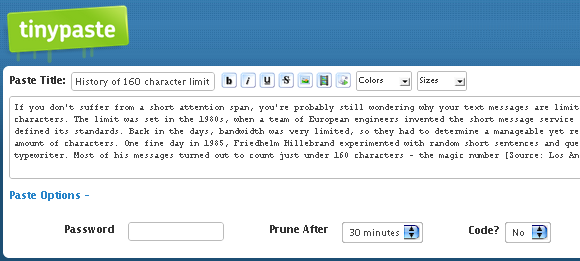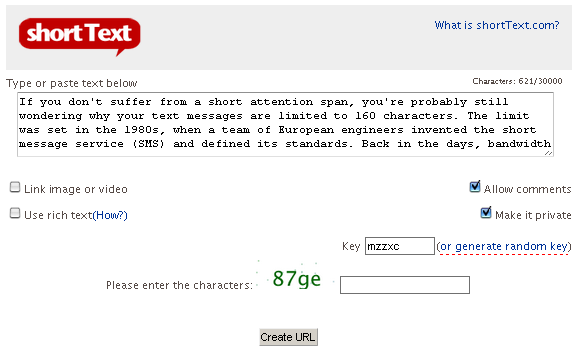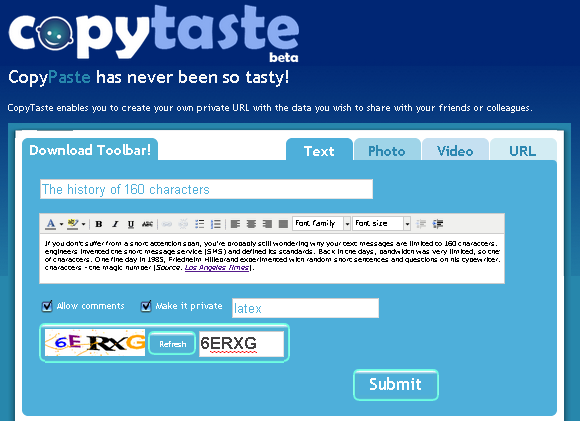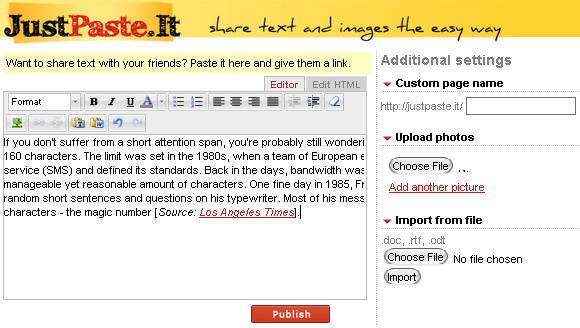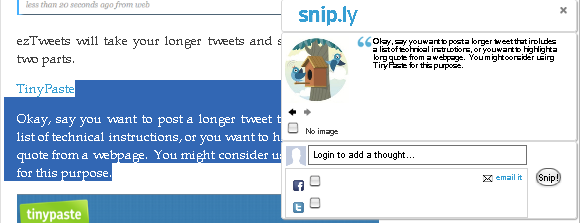Did you ever wonder why text messages on your mobile phone are limited to 160 characters?
The first text message was sent in 1992 and texting soon became a mass phenomenon. Subsequently, the magic number of 160 characters was adopted for other forms of communication and today we see similar character limits on micro blogging platforms like Twitter or Plurk. Twitter for example, reserves 20 characters for user names, hence bringing the limit down to 140 characters.
In the age of information overflow and short attention spans, the limit is a blessing because it forces brevity. On the other hand, a lot of information is lost. Fortunately, there are ways to escape the character limit. Below I will introduce 5 services that let you share text, images, videos, code, or formulas anywhere using a short URL. You don't even have to sign up.
TinyPaste
By far the most popular service is TinyPaste. You can share text, images, videos, or code snippets using a short URL. Each paste can be protected with a password and you can set it to self-delete after 30 minutes to 3 months. If you would like to manage your pastes, i.e. edit or delete them after posting, you have to sign up.
Standard Features:
- WYSIWYG text editor.
- insert images, videos, and code snippets.
- no character limit.
- set password.
- set paste to prune / self-delete after 30 minutes to 3 months.
- receive short URL to share paste.
Login Features:
- manage pastes.
Tools:
shortText
With shortText you can share up to 30,000 characters, link images and videos, and set a key for private access. The service provides no login option, making it perfectly simplistic. However, it has one key feature that distinguishes it from TinyPaste: you can enable comments.
Features:
- BB Code tag / rich text support.
- link images or videos.
- 30,000 character limit.
- allow comments.
- set key to make text private.
- receive short URL to share text.
CopyTaste
If you find shortText too simplistic, but like the idea of comments, try CopyTaste. In addition to making your snippets interactive, you can also embed videos and upload photos from your hard drive to create a gallery. Before you can 'TasteIt', i.e. submit your post, you are asked to specify whether your snippet is safe for work and select a language. You may also set tags. To manage your posts, you can sign up or log in with your Google, Yahoo, MySpace, Windows Live, Twitter, Facebook, and several other accounts.
Standard Features:
- WYSIWYG text editor.
- add URLs.
- upload photos.
- share video URL or embed code.
- allow comments.
- set password.
- tag posts.
- receive short URL to share data.
Login Features:
- login using Google, Facebook, Twitter, OpenID, or other existing accounts.
- manage posts.
- profile page.
- blog page.
- inbox.
Tools:
- Internet Explorer and Firefox Toolbar.
JustPaste.It
With the united features of the above services we should have covered just about anything, right? Wrong! There is a geeky reason why JustPaste.It made this list: you can enter mathematical formulas using LaTeX. Moreover, you can upload photos, embed videos, import text files from your computer, and export the result to PDF. Best of all, while you edit your post, it is saved every 3 minutes, so you don't have to worry about losing anything.
Features:
- WYSIWYG editor.
- HTML editor.
- automatic backup every 3 minutes while editing.
- upload photos.
- embed videos.
- import .doc, .rtf, and .odt files.
- insert mathematical formulas with LaTeX.
- export to PDF.
- create custom page name.
- receive short URL to share what you pasted.
snip.ly
Finally, here is a highly simplistic tool for occasions when you just want to share a text snippet from a single webpage.
What you do is enter the URL of the page that contains the piece of text you want to share. In the next step snip.ly loads the page and you highlight the respective paragraph. You can also browse through available images to add a thumbnail. To comment your selection you can log in using Twitter or Facebook or email your snip. As with all these services, you receive a short URL. Your snip appears in the foreground of the source page. Closing the snip reveals the underlying page and the snip can be loaded again through the toolbar.
Features:
- share text from any website.
- receive a short URL to share snips.
Login Features:
- log in using Facebook or Twitter.
- add personal comment.
- view recent snips.
- RSS feed for your snips.
Tools:
- Chrome extension
- Bookmarklet
If you do not suffer from a short attention span, you're probably still wondering why your text messages are limited to 160 characters. The limit was set in the 1980s, when a team of European engineers invented the short message service (SMS) and defined its standards. Back in the days, bandwidth was very limited, so they had to determine a manageable yet reasonable amount of characters. One fine day in 1985, Friedhelm Hillebrand experimented with random short sentences and questions on his typewriter. Most of his messages turned out to count just under 160 characters - the magic number [Source: Los Angeles Times].
A selection of Twitter-specific services are summarized in Bakari's article 6 Tools That Allow You To Write Longer Twitter Tweets.
How do you manage to compress your life experiences into 140 - 160 characters?
Image credits: ARENA Creative


